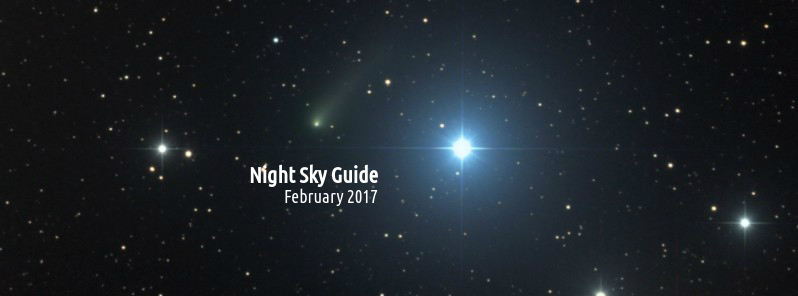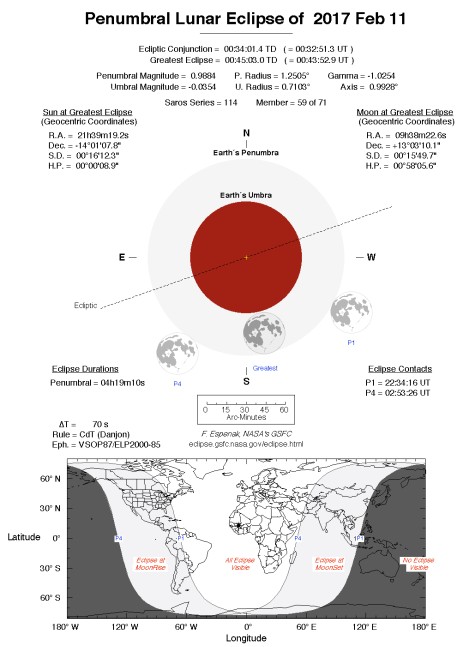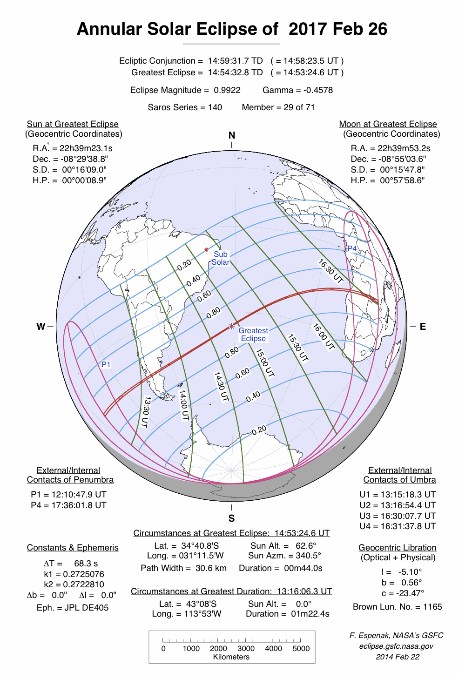Night sky guide for February 2017

A penumbral lunar eclipse will take place at 00:45 UTC on February 11. Although the Moon's light dims considerably during a penumbral eclipse, this is only perceptible to those with very astute vision, or in carefully controlled photographs. The eclipse will be visible throughout most of eastern South America, eastern Canada, the Atlantic Ocean, Europe, Africa, and western Asia.
An annular solar eclipse will take place on February 26. The Moon will be too far away from the Earth to completely cover the Sun, resulting in a ring of light around the darkened Moon. The path of the eclipse will begin off the coast of Chile and pass through southern Chile and southern Argentina, across the southern Atlantic Ocean, and into Angola and Congo in Africa. A partial eclipse will be visible throughout parts of southern South America and southwestern Africa.
The Moon will pass close to the Sun and become lost in the Sun's glare for a few days – new moon – on February 26. This is the best time of the month to observe faint objects such as galaxies and star clusters because there is no moonlight to interfere.
-
February 1 – Close approach of the Moon and Mars – 02:32 UTC. The Moon, 4 days old, and Mars will make a close approach, passing within 2°12' of each other. The Moon will be at mag -10.9, and Mars at mag 0.7, both in the constellation Pisces. The pair will be too widely separated to fit within the field of view of a telescope but will be visible to the naked eye or through a pair of binoculars.
-
February 2 – Conjunction of the Moon and Eris – 18:37 UTC. The Moon and 136199 Eris will share the same right ascension, with the Moon passing 8°41' to the north of 136199 Eris. The Moon will be 5 days old, at mag -11.6 in the constellation Pisces, and 136199 Eris at mag 18.7 in the neighboring constellation of Cetus.
-
February 3 – Close approach of the Moon and Ceres – 00:58 UTC. The Moon and 1 Ceres will make a close approach, passing within 0°59' of each other. The Moon will be at mag -11.7, and 1 Ceres at mag 7.9, both in the constellation Pisces. The pair will be a little too widely separated to fit comfortably within the field of view of a telescope but will be visible through a pair of binoculars. At around the same time, the two objects will also share the same right ascension – called a conjunction.
-
February 3 – Conjunction of the Moon and Ceres – 01:30 UTC. The Moon and 1 Ceres will share the same right ascension, with the Moon passing 1°02' to the north of 1 Ceres. The Moon will be at mag -11.7, and 1 Ceres at mag 7.9, both in the constellation Pisces. The pair will be too widely separated to fit within the field of view of a telescope but will be visible through a pair of binoculars.
-
February 4 – Moon at first quarter – 04:20 UTC. The Moon will be prominent in the evening sky, setting around midnight. At this time in its monthly cycle of phases, it appears almost exactly half illuminated. Over coming days, the Moon will set later each day, becoming visible for more of the night. Within a few days, it will not make it very far above the eastern horizon before nightfall. By the time it reaches full phase, it will be visible for much of the night, rising at around dusk and setting at around dawn.
-
February 7 – NGC 2808 well placed for observation. Across much of the world, the globular cluster NGC 2808 in Carina will be well placed for observation. It will reach its highest point in the sky at around midnight local time. At a declination of -64°52', it is easiest to see from the southern hemisphere but cannot be seen from latitudes much north of 5°N. At magnitude 6.3, NGC2808 is quite faint, and certainly not visible to the naked eye, but can be viewed through a pair of binoculars or a small telescope.
-
February 9 – Comet 45P/Honda-Mrkos-Pajdusakova reaches its brightest. Comet 45P/Honda-Mrkos-Pajdusakova is forecast to reach its brightest, at around mag 6.6. It will lie at a distance of 0.95 AU from the Sun, and at a distance of 0.09 AU from the Earth.
-
February 11 – Full Moon – 00:34 UTC. At this time in its monthly cycle of phases, the Moon lies almost directly opposite the Sun in the sky, placing it high above the horizon for much of the night. The sequence of full moons through the year are often assigned names according to the seasons in which they fall. Over the nights following February 11, the Moon will rise around an hour later each day, becoming prominent later in the night. Within a few days, it will only be visible in the pre-dawn and early-morning sky. By the time it reaches last quarter, a week after full moon, it will rise at around midnight and set at around noon. At the exact moment when the Moon reaches full phase, it will lie at a declination of +13°09' in the constellation Leo, and so will appear highest in the northern hemisphere. It will be visible from all latitudes south of 66°S. Its distance from the Earth will be 377 000 km. This full moon was known by early Native American tribes as the Full Snow Moon because the heaviest snows usually fell during this time of the year. Since hunting is difficult, this moon has also been known by some tribes as the Full Hunger Moon, since the harsh weather made hunting difficult.
-
February 11 – Penumbral lunar eclipse – 00:45 UTC. Like other lunar eclipses, penumbral eclipses occur whenever the Earth passes between the Moon and Sun, such that it obscures the Sun's light and casts a shadow onto the Moon's surface. But unlike other kinds of eclipses, they are extremely subtle events to observe. In a penumbral eclipse, the Moon passes through an outer region of the Earth's shadow called the penumbra. This is the outer part of the Earth's shadow, in which the Earth appears to cover part of the Sun's disk, but not all of it. As a result, the Moon's brightness will begin to dim, as it is less strongly illuminated by the Sun, but the whole of the Sun's disk will remain illuminated to some degree. Although the Moon's light dims considerably during a penumbral eclipse, this is only perceptible to those with very astute vision, or in carefully controlled photographs. The eclipse will be visible throughout most of eastern South America, eastern Canada, the Atlantic Ocean, Europe, Africa, and western Asia.

Credit: NASA/F. Espenak
-
February 15 – Comet C/2014 S2 (PANSTARRS) reaches its brightest. Comet C/2014 S2 (PANSTARRS) is forecast to reach its brightest, at around mag 12.6. It will lie at a distance of 5.01 AU from the Sun, and at a distance of 4.38 AU from the Earth.
-
February 15 – Conjunction of the Moon and Makemake – 00:49 UTC. The Moon and 136472 Makemake will share the same right ascension, with the Moon passing 27°35' to the south of 136472 Makemake. The Moon will be 18 days old.
-
February 15 – Close approach of the Moon and Jupiter – 16:37 UTC. The Moon and Jupiter will make a close approach, passing within 2°33' of each other. The Moon will be 18 days old. They will then reach its highest point in the sky at 03:41, 36° above your southern horizon. They will be lost to dawn twilight at around 06:39, 23° above your south-western horizon. The Moon will be at mag -12.3, and Jupiter at mag -2.3, both in the constellation Virgo. The pair will be too widely separated to fit within the field of view of a telescope but will be visible to the naked eye or through a pair of binoculars.
-
February 16 – Conjunction of the Moon and Haumea – 14:26 UTC. The Moon and 136108 Haumea will share the same right ascension, with the Moon passing 25°13' to the south of 136108 Haumea. They will be lost to dawn twilight at around 06:37, 50° above your south-western horizon. The Moon will be at mag -12.2 in the constellation Virgo, and 136108 Haumea at mag 17.2 in the neighboring constellation of Bootes. The Moon will be 19 days old.
-
February 17 – Venus at greatest brightest – 07:29 UTC. Venus will be well placed for observation in the evening sky, shining brightly at mag -5.5. It will then sink towards the horizon, setting 3 hours and 43 minutes after the Sun at 21:04. Venus's orbit lies closer to the Sun than the Earth's, meaning that it always appears close to the Sun and is very difficult to observe most of the time. It is observable only for a few weeks each time it reaches greatest separation from the Sun – moments referred to as greatest elongation. On these occasions, however, Venus is so bright and conspicuous that it becomes the third brightest object in the sky after the Sun and Moon. It is often called the morning or evening star.
-
February 18 – M81 well placed for observation. Bode's Galaxy (M81, NGC 3031) in Ursa Major will be well placed for observation. It will reach its highest point in the sky at around midnight local time. At a declination of +69°04', it is easiest to see from the northern hemisphere but cannot be seen from latitudes much south of 0°S. At magnitude 6.9, M81 is quite faint, and certainly not visible to the naked eye, but can be viewed through a pair of binoculars or a small telescope.
-
February 18 – Asteroid 14 Irene at opposition – 12:33 UTC. Asteroid 14 Irene will be well placed for observation, lying in the constellation Leo, well above the horizon for much of the night. Regardless of your location on the Earth, 14 Irene will reach its highest point in the sky at around midnight local time.
-
February 18 – Moon at last quarter – 19:35 UTC. The Moon will be prominent in the dawn sky, rising at around midnight. Over coming days, the Moon will rise later each day, so that it is visible for less time before sunrise and it less far above the eastern horizon before dawn. By the time it reaches new moon, it will rise at around dawn and set at around dusk, making it visible only during the daytime.
-
February 20 – NGC 3114 well placed for observation. Across much of the world, the open star cluster NGC 3114 in Carina will be well placed for observation. It will reach its highest point in the sky at around midnight local time. At a declination of -60°07', it is easiest to see from the southern hemisphere but cannot be seen from latitudes much north of 9°N. At magnitude 4.2, NGC3114 is tricky to make out with the naked eye except from a dark site but is visible through a pair of binoculars or a small telescope.
-
February 20 – Asteroid 15 Eunomia at opposition – 05:53 UTC. Asteroid 15 Eunomia will be well placed for observation, lying in the constellation Sextans, well above the horizon for much of the night. Regardless of your location on the Earth, 15 Eunomia will reach its highest point in the sky at around midnight local time.
-
February 21 – Close approach of the Moon and Saturn – 23:54 UTC. The Moon and Saturn will make a close approach, passing within 3°34' of each other. The Moon will be at mag -11.3 in the constellation Sagittarius, and Saturn at mag 0.2 in the neighboring constellation of Ophiuchus. The pair will be too widely separated to fit within the field of view of a telescope, but will be visible to the naked eye or through a pair of binoculars. The Moon will be 23 days old.
-
February 22 – Asteroid 9 Metis at opposition – 06:19 UTC. Asteroid 9 Metis will be well placed for observation, lying in the constellation Leo, well above the horizon for much of the night. Regardless of your location on the Earth, 9 Metis will reach its highest point in the sky at around midnight local time.
-
February 22 – Conjunction of the Moon and Pluto – 20:18 UTC. The Moon and 134340 Pluto will share the same right ascension, with the Moon passing 2°47' to the north of 134340 Pluto. The Moon will be at mag -10.6, and 134340 Pluto at mag 14.9, both in the constellation Sagittarius. The pair will be too widely separated to fit within the field of view of a telescope but will be visible through a pair of binoculars. The Moon will be 25 days old.
-
February 26 – IC2681 well placed for observation. Across much of the world, the open star cluster IC 2581 in Carina will be well placed for observation. It will reach its highest point in the sky at around midnight local time. At a declination of -57°37', it is easiest to see from the southern hemisphere but cannot be seen from latitudes much north of 12°N. At magnitude 4.3, IC2581 is tricky to make out with the naked eye except from a dark site but is visible through a pair of binoculars or a small telescope.
-
February 26 – Conjunction of the Moon and Mercury – 02:27 UTC. The Moon and Mercury will share the same right ascension, with the Moon passing 2°29' to the north of Mercury. The Moon will be at mag -6.5, and Mercury at mag -1.8, both in the constellation Aquarius. The pair will be too widely separated to fit within the field of view of a telescope but will be visible to the naked eye or through a pair of binoculars.
-
February 26 – New Moon – 15:00 UTC. The Moon will pass close to the Sun and become lost in the Sun's glare for a few days. This is the best time of the month to observe faint objects such as galaxies and star clusters because there is no moonlight to interfere.
-
February 26 – Annular solar eclipse – 14:54 UTC. An annular solar eclipse occurs when the Moon is too far away from the Earth to completely cover the Sun. This results in a ring of light around the darkened Moon. The Sun's corona is not visible during an annular eclipse. The path of the eclipse will begin off the coast of Chile and pass through southern Chile and southern Argentina, across the southern Atlantic Ocean, and into Angola and Congo in Africa. A partial eclipse will be visible throughout parts of southern South America and southwestern Africa.

-
February 27 – Close approach of Mars and Uranus – 23:51 UTC. Mars and Uranus will make a close approach, passing within 0°34' of each other. Mars will be at mag 1.0, and Uranus at mag 5.9, both in the constellation Pisces. The pair will be a little too widely separated to fit comfortably within the field of view of a telescope but will be visible through a pair of binoculars. At around the same time, the two objects will also share the same right ascension – called a conjunction.
-
February 27 – Conjunction of Mars and Uranus – 08:18 UTC. Mars and Uranus will share the same right ascension, with Mars passing 0°37' to the north of Uranus. At around the same time, the two objects will also make a close approach, technically called an appulse. Mars will be at mag 1.0, and Uranus at mag 5.9, both in the constellation Pisces. The pair will be a little too widely separated to fit comfortably within the field of view of a telescope but will be visible through a pair of binoculars.
-
February 28 – Conjunction of the Moon and Venus – 20:00 UTC. The Moon and Venus will share the same right ascension, with the Moon passing 10°15' to the south of Venus. The Moon will be at mag -9.7 in the constellation Cetus, and Venus at mag -5.4 in the neighboring constellation of Pisces. The pair will be too widely separated to fit within the field of view of a telescope or pair of binoculars but will be visible to the naked eye.

Video courtesy Hubble Space Telescope
Sources: In The Sky by Dominic Ford, NASA
Featured image: Comet C/2014 S2 (PANSTARRS) on September 13, 2015. Credit: Damian Peach. Edit: TW

Commenting rules and guidelines
We value the thoughts and opinions of our readers and welcome healthy discussions on our website. In order to maintain a respectful and positive community, we ask that all commenters follow these rules:
We reserve the right to remove any comments that violate these rules. By commenting on our website, you agree to abide by these guidelines. Thank you for helping to create a positive and welcoming environment for all.